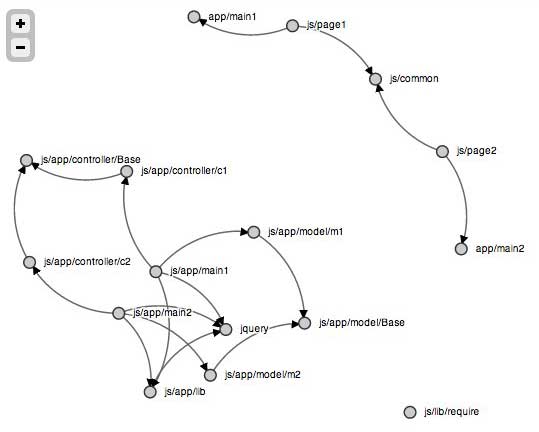Visualize your CommonJS, AMD, or ES6 module dependencies in a force directed graph report - powered by D3.js.
NEW MAINTAINER WANTED: This project hasn't been maintained in while, so if you wanna help out, please let me know!
Let me introduce dependo - A small visualization tool that draws an force directed graph of JavaScript dependencies pulled from a codebase of CommonJS, AMD, or ES6. Behind the scene I’m using a wonderful library named node-madge, to extract the dependencies and combined with the power of D3.js I draw a beautiful zoomable directed graph.
You can read the full introduction to the project in my blog post.
- Draw a graph of nodes, where each module is represented as a node.
- Google Maps's like zooming, dragging and panning.
- Connect nodes with it's dependencies via lines.
- Hovering a node will highlight it's direct dependencies.
- It's possible to drag a node to a specific position, to re-layout the graph.
The best way to show something is by example, so here I generated a graph of the official RequireJS multipage example:
See the example here: http://auchenberg.github.com/dependo/example
To install as a library:
$ npm install dependo
To install the command-line tool:
$ sudo npm -g install dependo
{
'format': The module format to expect, 'cjs', 'amd', 'es6', or 'json'. AMD (amd) is the default format. If 'json', pass a file formatted like `example.json` in the `example/` directory.
'optimized': Boolean, True if the parser should read modules from a optimized file (r.js). Defaults to false.
'exclude': String from which a regex will be constructed for excluding files from the scan.
'mainRequireModule': Name of the module if parsing an optimized file (r.js), where the main file used require() instead of define. Defaults to ''.
'requireConfig': Path to RequireJS config used to find shim dependencies and path aliases. Not used by default.
'reverse': Reverse dependency arrow directions.
'title': The title of the generated HTML document.
'extensions': Valid file extensions used to find files in directories e.g. .js,.ts Default: .js
} var Dependo = require('dependo');
// Fire up an dependo instance
var dependo = new Dependo(src, {
format: 'amd',
requireConfig: 'optional path to RequireJS config file',
exclude: '^node_modules',
transform: function(dep){
//Apply a transformation on dependencies
....
return dep;
}
});
dependo.generateHtml();
...Usage: dependo [options] <file|dir ...>
Options:
-h, --help output usage information
-V, --version output the version number
-f, --format <name> format to parse (amd/cjs/es6/json)
-x, --exclude <regex> a regular expression for excluding modules
-t, --title <title> the title of the generated document (dependo)
-v, --reverse reverse direction of arrows
-e, --extensions file extensions to use separated by comma
$ dependo -f amd /path/src > example/report.html
I also wrote a grunt-task that can be found in this separate repository: https://github.com/auchenberg/grunt-dependo
dependo is still very much in progress, so here is the todo-list:
- Proper label positioning: Avoid label collisions and make the graph more readable.
- Testing! Unit tests of D3 render logic, and the grunt-task itself
This project wouldn't have been possible without the great work on node-madge by Patrik Henningson, or wonderful D3.js library.




